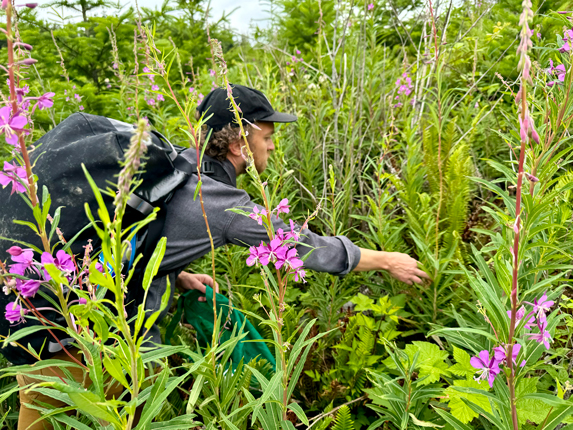
‘Tastes like hard work:’ Inside a foraging hike on the Kitsap Peninsula
Listen
(Runtime 3:46)
Read
One craft brewery in Seattle is hoping to bring the flavors of the Northwest to beer — and, no, we’re not talking fresh hops. Fair Isle Brewing is foraging everything from sugar kelp to elderflower to create subtle, homegrown notes in their brews.
“Beer doesn’t have to be like the traditional ingredients,” said Andrew Pogue, the brewery’s co-founder.
That’s traditional ingredients sourced from vendor catalogs or online, he said. Instead, he wanted people’s palates to relish flavors from around the Northwest.
So, a group from the brewery headed to the Kitsap Peninsula, a quick car and ferry ride from the brewery. Pogue and two other crew members headed into the woods to search for fireweed.
“Lots of times when we forge fireweed, it’s in a clear-cut area because that’s where it thrives in the abundance of the sun,” Pogue said.
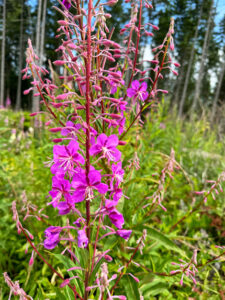
Fireweed grows in areas burned by wildfires or disturbed by clear-cuts. It was among the plants to sprout up after Mount Saint Helens erupted in 1980. (Credit: Courtney Flatt / NWPB)
As its name suggests, the weed is also fond of areas burned by wildfires. To prove its love of disturbed landscapes, fireweed was among the plants to sprout up after Mount Saint Helens erupted in 1980.
“All the flowers will bloom and then they’ll slowly fall off. They say whenever the last one falls off, there’s six weeks left until summer ends,” said Mikey Jones, who works as front of the house staff at Fair Isle. “It turns into, like, cotton and blows away. And the seeds from the cotton spread it.”
A mile uphill, and the Fair Isle foragers reach a clear-cut, with popular mountain biking and hiking trails snaking through.
“Now that we’re in this clear-cut area, we’ll start to see fireweed,” Pogue said, as the group turned a corner. “So this is all fireweed. There’s tons of fireweed.”
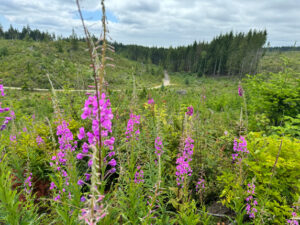
The Fair Isle crew foraged in a clear-cut, with popular mountain biking and hiking trails snaking through. (Credit: Courtney Flatt / NWPB)
The goal of the day was to collect enough of the wildflower’s long, green leaves to fill four reusable grocery bags they’ve brought along — roughly 10 pounds of leaves.
The plant’s bright, fuchsia blossoms remained untouched. As vibrant as the flowers are, they aren’t that flavorful, Pogue said.
“We use the leaves of the weed and dry them just like you would to green tea and add them to beer and steep them just like you would a tea,” he said.
They’ll use the leaves to make a saison-style beer, the Alexandra.
For this team, foraging was all about the here and now.
“You really have to be attuned with what’s in season,” Pogue said. “Is that coming early? Is it showing up late this year? How long is the winter? Being forced to pay attention to that aspect of nature is always really, really fun.”
To do that, they’ve foraged from different regions in Washington at different times. The team’s searched for everything from bog myrtle in swampy sloughs to elderflower in the eastern Cascades.
But Pogue said they don’t collect anything they’re foraging all in one spot.
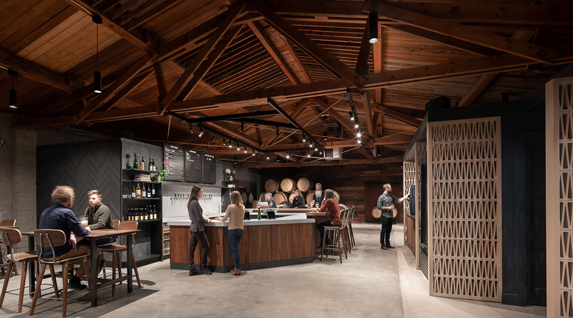
Fair Isle Brewing is in Seattle’s Ballard neighborhood. To collect fireweed, a group that works at the brewery traveled to the Kitsap Peninsula. (Credit: Fair Isle Brewing)
“We make sure that what we use in our beers (that we forage without) decimating a population,” he said.
Fortunately, fireweed is abundant.
“Once you see it, you’ll see it everywhere,” Pogue said.
They grab their bags to collect leaves and head off into the clear-cut, attempting to take leaves from plants not so near the trail and leaving as little a trace as possible.
“We only take about a third of the leaves off the plant and leave the flowers,” Pogue said. “That allows the plant to continue living and allows the bees to keep pollinating, and everything keeps kind of going about its business.”
Pogue started his business during the pandemic with the goal of creating beers that reflect different parts of the state.
“The cool thing about Washington is that there’s such an abundance of ingredients,” he said.
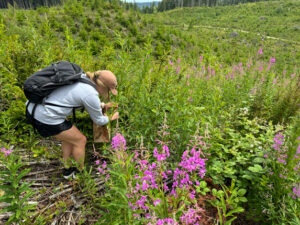
Olivia Mitchell, an assistant brewer at Fair Isle Brewing, picks fireweed on the Kitsap Peninsula. (Credit: Courtney Flatt / NWPB)
Olivia Mitchell, an assistant brewer at Fair Isle, stuffed her bag with fireweed leaves after about an hour or so of hiking.
“It’s cool to find something from around here that just grows from the ground and then use it immediately. And taste it immediately afterward,” she said. “You feel more connected to the area.”
The group typically forages fireweed June through August, a big foraging window compared to other ingredients. They’ll go out a few times a season.
When they’re experimenting with flavors and ingredients they’ll sometimes make small batches, Pogue said.
“You can essentially go out, try some ingredients. That’s a good way to mimic how that might appear to beer,” he said. “From there, you can kind of start playing, almost like a palette of paints, mix these different things and blend them. So we get excited.”
Sometimes they nail a new beer. Sometimes it needs quite a bit of tweaking, Pogue said. But, August will be the fourth batch of the Alexandra. Fair Isle brews it seasonally to release in the summer, Pogue said.
After the hike, the group sat down to enjoy a sip.
Pogue opens a bottle of the Alexandra saison.
“You get a little bit of bitterness, herbaceous qualities,” he said.
“Oh yeah. I love it,” Mitchell said.
“Smells like hard work. Tastes like hard work, too,” Jones said.
The leaves they picked will be released in next year’s beer. For now, Pogue said he was glad to be out of the office, away from the computer.
“There’s a part of you that feels more alive after gathering. Right?” he said. “You have that connection to the world around us.”















